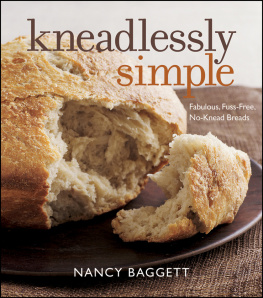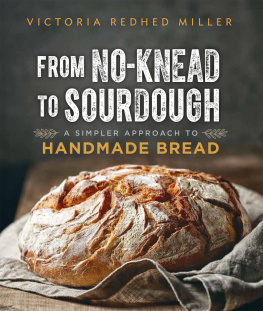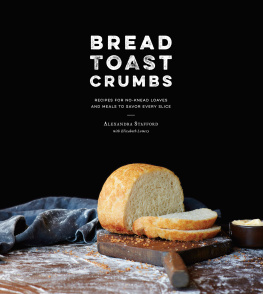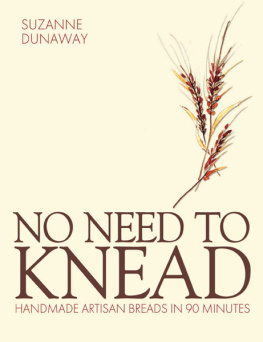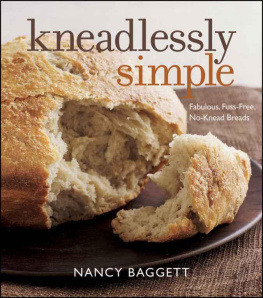The no-knead bread method has revolutionized bread baking. The average family can now have fresh from the oven bakery quality artisan bread in the convenience of their own home with little or no-kneading... Mother Nature does the kneading for you. No-yeast proofing... instant yeast does not need to be proofed in warm water prior to using. No mixer... ingredients can be combined with a spoon. It's almost as easy as making a bowl of Campbell's soup.
This is New Age Bread Baking. I understand what Italian bread, French bread, and baguettes are, and I understand the proper techniques for making those breads, but we live in a new age and we should embrace new ideas. Instead of trying to emulate bread methods of the past we should focus on our goal... to make great tasting, bakery quality, artisan bread with the methods and techniques that fit our busy schedules.
I believe in Smart & Easy. Note, I didnt say fast and cheap. I make no-knead bread because its the smartest, easiest, way to make bakery quality artisan bread and I believe my readers and subscribers are attracted to the no-knead method for the same reasons. In response to my readers and subscribers, I strive for convenience and address each recipe from a very practical standpoint... as, I believe, they would want me to develop my recipes.
I think youll enjoy this cookbook.
Two Basic Methods for Making No-Knead Bread
There are two basic methods traditional and turbo.
Traditional No-Knead Bread proof for 8 to 24 hours
The traditional no-knead method uses long proofing times (8 to 12 hours) to develop flavor and was designed to be baked in a Dutch oven. The purpose of the Dutch oven is to emulate a bakers oven by trapping the moisture from the dough in a screaming hot, enclosed environment. This is an excellent method for making artisan quality bread.
Recommended YouTube video: Worlds Easiest Bread Recipe & Technique for Beginners (no kneading using hands-free technique) (Oct 6, 2015 6:52)
No-Knead Turbo Bread ready to bake in 1-1/2 hours
The no-knead Turbo method uses shorter proofing times (ready to bake in 2-1/2 hours) and was designed to be baked in traditional bakeware (bread pan, etc.). It was designed for those who want to make no-knead bread, but dont want to wait 8 to 24 hours. Those who want bread machine bread, but dont want to buy and store a bread machine. Its for those of you who want a fast reliable way to make fresh from the oven bread without the hustle of expensive machines, Dutch ovens, or kneading.
Recommended YouTube video: Ultimate Introduction to No-Knead Turbo Bread ready to bake in 2-1/2 hours (Mar 8, 2015 9:03 min)
Advantages of No-Knead Bread
(1) No kneading Mother Nature does the kneading for you.
(2) No yeast proofing instant yeast doesnt require proofing.
(3) No special equipment (no mixer, no bread machine) the entire process is done in a glass bowl with a spoon and a spatula and can be baked in a wide variety of baking vessels (standard bread pan, uncovered baker, skillet, preheated Dutch oven, etc.).
(4) Only uses 4 basic ingredients (flour, salt, yeast and water) to which other ingredients can be added to make a variety of specialty breads.
Advantages of the Traditional Method
(1) If you want bread tomorrow. When I the dough is proof over night it is available at your convenience any time the next day it fits easily into your schedule.
Advantages of Turbo Method
(1) If you want bread later today. Shorter proofing time bread is ready to bake in less than 2-1/2 hours.
(2) Some have said, no-knead Turbo bread is bread machine bread without the bread machine. I like to think of it as a way for the average family to have fresh from the oven bread in the convenience of their homes without special equipment or any hassles.
What makes my Technique Unique
(1) Hands-free technique uses the handle end of a plastic spoon to manipulate the dough (like a dough hook) which allows the dough to go straight from the mixing bowl to the baking vessel (bread pan, etc.) without dusting the work surface with flour or touching the dough.
(2) Roll-to-coat an innovative technique that coats the dough ball with flour in the mixing bowl. No more sticky dough. When the dough comes out of the bowl it will be easy to handle if you wish to divide the dough into portion to make baguettes, rolls, etc.
I know when food is supposed to be served in a bowl with a name on it.
Fran Fine - The Nanny

Ingredients
It only takes four ingredients to make bread... flour, salt, yeast and water.
Flour
Flour is the base ingredient of bread and there are four basic types of flour...
(1) Bread flour is designed for yeast bread. It has a higher percentage of gluten which gives artisan bread its airy crumb.
(2) All-purpose flour has less gluten than bread flour. I use all-purpose flour for biscuits, flatbreads, etc. In other words... I use it when I dont want an airy crumb.
(3) Self-rising flour is all-purpose flour with baking soda and baking powder added as leavening agents. Its intended for quick breads... premixed and ready to go. Do not use self-rising flour to make yeast bread. To see the difference between yeast and quick breads you may want to watch Introduction to No-Knead Beer Bread (a.k.a. Artisan Yeast Beer Bread) and Introduction to Quick Beer Bread (a.k.a. Beer Bread Dinner Rolls) .
(4) And there are a variety of specialty flours ... whole wheat, rye, and a host of others. Each has its unique flavor and characteristics. In some cases, you can substitute specialty flour for bread flour, but you may need to tweak the recipe because most specialty flours have less gluten. I frequently blend specialty flour with bread flour.
Flour is the primary ingredient... if you dont use the correct flour you wont get the desired results.
Note: To know how many cups of flour there are in a specific bag its typically on the side in Nutritional Facts. For example, this bag reads, Serving Size 1/4 cup Serving Per Container about 75. In other words 18.75 (75 times 1/4). Thats the technical answer, but in the real world (measuring cup versus weight) a bag of flour will measure differently based on density (sifted versus unsifted), type of flour (wheat is more dense than bread flour), humidity (flour weighs more on humid days), and all the other variables life and nature have to offer. Thus, there is no single correct answer, but for practical purposes figure a 5 lb bag of bread flour is 17 to 18 cups.


